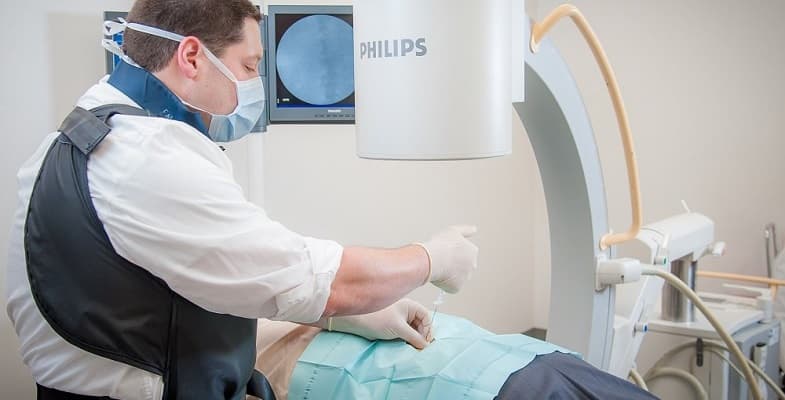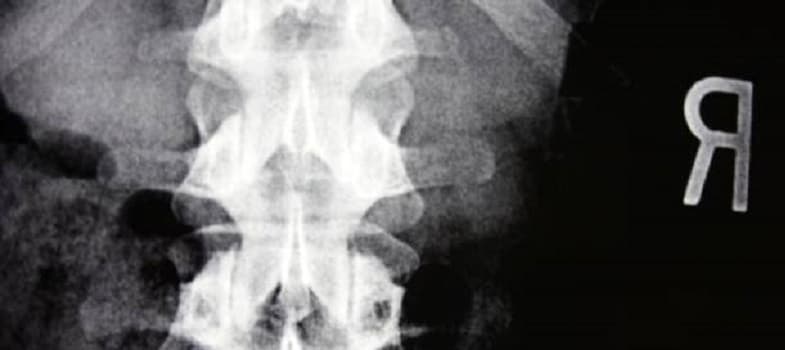What Are Lumbar Epidural Steroid Injections?
Lumbar epidural steroid injections are a non-surgical form of treatment for lower back pain and radicular pain. This technique was first introduced during the 1950s as a novel treatment for lumbar back pain and sciatic nerve pain.
Lumbar pain refers to discomfort in the lower regions of the back that may extend into the buttocks and down the legs.
The purpose of epidural steroid injections is to administer medication to irritated or inflamed nerves in order to decrease inflammation. The medication is a combination of an anesthetic and steroids. If the injection is performed successfully, it can provide almost immediate pain relief in the lumbar region of the back and may also improve other symptoms that may be occurring such as numbness, weakness, tingling, and pain in the lower extremities.
In addition to being used for the management of back pain, a lumbar epidural steroid injection is also commonly used as a diagnostic test. More specifically, a physician may try to pinpoint the exact region where the affected nerves are located by injecting the medication into a specific area of the lower back. If the pain dramatically decreases or stops after the injection, then the physician can conclude that the pain source has been properly identified.
An effective diagnostic injection also confirms the notion that inflamed nerves were contributing to the pain. If two steroid injections provide a patient with significant pain relief, then a treatment plan that offers more long-term results such as receiving additional injections and physical therapy or the possibility of undergoing surgery can be discussed.
How Are Lumbar Epidural Steroid Injections Performed?
To provide a better understanding of the injection procedure and the region that the medication is administered, the spinal region will first be briefly described. There are a vast number of nerves that run along the spinal cord. The nerves extend throughout the entire body and are protected by cerebrospinal fluid (CSF). The spinal cord is also stabilized by a tough membrane within the spinal column. The area that is directly outside of the membrane is referred to as the epidural space. The roots of damaged, irritated, or inflamed nerves, which are the targets for the steroid injections, are located in the epidural space.
There are three ways in which physicians can perform a lumbar epidural steroid injection: directly through the middle region of the back through what is called an interlaminar approach; through the sides of the back, referred to as a transforaminal approach; or through the tailbone, through what is called the caudal approach.

Clinical studies have repeatedly shown that steroid injections for lumbar back pain are quite effective. Additionally, research has indicated that the administration of steroid injections during the early stages of the pain development can often help patients avoid having to undergo a more invasive spinal procedure such as surgery. Epidural steroid injections can also be repeated if the first injection was only minimally effective and this also increases the long-term results of the procedure.
A recently published clinical trial reviewed the outcomes of patients who received one or more lumbar steroid injections to treat herniated discs in comparison to those who chose not to receive the injections. Approximately 50% of the individuals who received the steroid injections were able to avoid back surgery, while only 19% of those who did not receive the injections were able to avoid back surgery.
The procedure is non-surgical and relatively painless, but some side effects may occur such as minor bleeding at the injection site, the development of an infection, increased blood sugar levels, hot flashes, and insomnia.
Conditions Associated With Epidural Lumbar Steroid Injections
Since the establishment of steroid injections, various conditions have been successfully treated with this approach. These include:
- Spinal stenosis, a condition in which the spinal canal becomes abnormally narrow
- Spondylolysis, a condition that refers to the degeneration of spinal tissue
- A herniated disc, which is the result of a ruptured or bulging spinal disc
- Degenerative disc disease, a condition that develops as a result of the gradual wear and tear of spinal discs
- Lumbar radiculopathy, a condition that refers to lumbar back pain that radiates into the buttocks and legs due to compressed spinal nerves
Conclusion
Lumbar epidural steroid injections are a treatment approach that is becoming commonly used for the management of back pain. As lumbar back pain is a very common health problem for many adults, this treatment approach is now recommended quite often before surgery. In many cases, patients who receive steroid injections report rapid pain relief, enhanced mobility, and the ability to return to their normal lives without having to undergo back surgery.
References
- Coliman F, Villalobos F. Epidural steroid injections: Evidence and technical aspects. Techniques in Regional Anesthesia and Pain Management. 2010;14;113-119.
- Collighan N, Gupta E. Epidural steroids. Brit J Anaesth. 2010;109(1):1-5.
- Friedrich J, harrast M. Lumbar epidural steroid injections: indications, contraindications, risks, and benefits. Current Sports Medicine Reports. 2010;9(1):43-49.
- Ghai B, Vadajae KS, Wig J, Dhillon MS. Lateral parasagittal veres midline interlaminar lumbar epidural steroid injection for management of low back pain with lumbosacral radicular pain: A double-blind randomized study. Anesth Analg. 2013;117(10):219-227.
- Manchikanti L, Cash K, McManus C, Damron K, Pampati V, falco F. Lumbar interlaminar epidural injections in central spinal stenosis: Preliminary results of a randomized, double-blind active control trial. Pain Physician. 2012;15:51-63.
- Sukdeb D, Ramsin M, Laxmaiah M. Evidence-based practice of lumbar epidural injections. Techniques in Regional Anesthesia and Pain Management. 2009;13:281-287.


